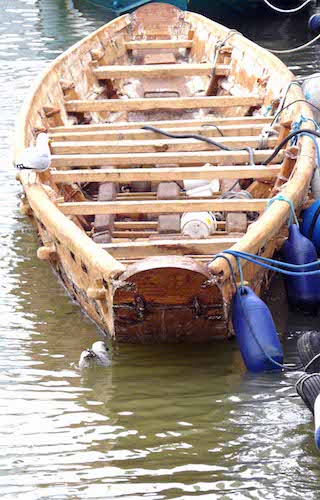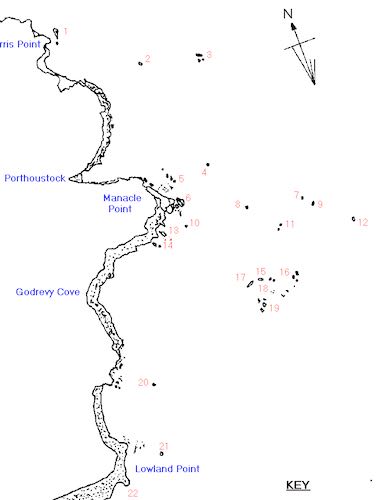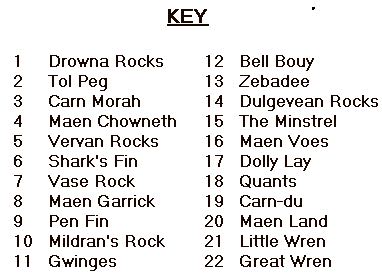 Ancient mariners, trade networks, ritual compulsion & a unique product revered through millennia before its final fading from use around the time St Keverne became a parish: part of the story I promised in an earlier episode of this Blog¹. Read on, if you must.
Ancient mariners, trade networks, ritual compulsion & a unique product revered through millennia before its final fading from use around the time St Keverne became a parish: part of the story I promised in an earlier episode of this Blog¹. Read on, if you must.
On occasion it is interesting to run time backwards & dream up scenarios out of which condense the realities of today. We are helped in this Dreamtime by factors we can't ignore but there is scope for the imagination to suggest things which might later be disproved. It's called the Scientific Method & is universally used to posit theories whose demise allows better theories to replace them. The rest of this article might be viewed in that light.
In considering the Lizard, which is what this Blog is about, lowering the sea level as we regress towards the most recent ice age included large areas of land which are now underwater. The Manacles become an island, with soil, a covering of loess and an admixture of guano then, earlier, part of the mainland itself. Resuming the normal flow of time we can imagine the river separating us from Brittany² widening as melting ice allowed water to become available to the sea & nautical technology keeping pace³ as the shores lost intervisibility.
Their present day name, whether a monastic association with the Meneage or the suggested Church Rocks of Mediaeval Christianity, is a latecomer. The individual reefs, I suggest, were named much earlier by local seamen whose interest was to know them well. Others may have had a collective name for them but it is lost, like the hundreds of vessels that have come to grief on them over the millennia, marine disasters numerous enough to crack the Lutine Bell⁴. To them this gathering of gabbro reefs, isolated from the mainland, denuded of vegetation, washed over by the tides, took on instead the mantle of a hazard to mariners.
Washed away by the tides along with the loess were the clay deposits into which gabbro decays over time, deposits which were a continuation of those on Lowland Point. It was due to the desirability of gabbroic clay that Neolithic fishermen added its export to their portfolio of talents. A protective mythology needed inventing and believing in: voices of the drowned could be heard at low tide; monsters waited to lure those without the mental charts which preceded the portolan; fear was added to the complex nature of reality. If the transport of clay was to be undertaken by outsiders they must have an adventurous spirit, its acquisition being a challenge for the intrepid willing to joust with the Manacles, at once lured and disenchanted by Kernewic Sirens: perhaps the journey edged the pilgrims' kudos up a notch in times before Hajji was added to the names of those seeking a different Mecca, or when a free meal at the Parador at Santiago de Compostella was compensation enough for blistered feet.
 Gabbroic clay was imbued with a degree of magic during most of its long shelf life. That it carried an aura of the faintly exotic is evidenced when found fired with admixtures of distant local clays, by themselves perfectly adequate for potting. By whatever pilgrimage, the clay travelled far - Brittany, Kent, London, Wiltshire, Dorset, Devon: it pervaded the whole of Cornwall until Roman influence drew a line between the Camel & Fowey estuaries, a political boundary⁵ which proved almost impermeable to its transit. East of this, the same families of potters continued to fabricate the same series of pots but in local clays, largely granitic. West of the line gabbroic pottery maintained its hold, morphing into platters & grass marked vessels. It is suggested⁶ that Pagan ritual associated with the industry grated with Christian dogma after the monastic establishment at St Keverne became entrenched &, by the time the Normans took an interest in the area, gabbro had lost its grip.
Gabbroic clay was imbued with a degree of magic during most of its long shelf life. That it carried an aura of the faintly exotic is evidenced when found fired with admixtures of distant local clays, by themselves perfectly adequate for potting. By whatever pilgrimage, the clay travelled far - Brittany, Kent, London, Wiltshire, Dorset, Devon: it pervaded the whole of Cornwall until Roman influence drew a line between the Camel & Fowey estuaries, a political boundary⁵ which proved almost impermeable to its transit. East of this, the same families of potters continued to fabricate the same series of pots but in local clays, largely granitic. West of the line gabbroic pottery maintained its hold, morphing into platters & grass marked vessels. It is suggested⁶ that Pagan ritual associated with the industry grated with Christian dogma after the monastic establishment at St Keverne became entrenched &, by the time the Normans took an interest in the area, gabbro had lost its grip.
 The unique geology of The Lizard provides unusual certainty for the origin of the raw materials which is restricted to an area about 5 miles by 2, including Crousa Downs, Main Dale and the coast between Coverack North Corner & Porthallow. Nowhere in England has deposits of gabbroic clay. Some of the prehistoric sites may well have been obliterated by subsequent extraction at Dean, St Keverne & West of England Quarries. It is suggested that a square kilometre near Zoar provided coarse material for typical gabbroic pottery & a loessic/gabbroic pottery fabric has been identified in sherds at Gear & Caervallack, likely as a result of the Time Team dig. This has now been matched with a clay source at Lowland Point⁷.
The unique geology of The Lizard provides unusual certainty for the origin of the raw materials which is restricted to an area about 5 miles by 2, including Crousa Downs, Main Dale and the coast between Coverack North Corner & Porthallow. Nowhere in England has deposits of gabbroic clay. Some of the prehistoric sites may well have been obliterated by subsequent extraction at Dean, St Keverne & West of England Quarries. It is suggested that a square kilometre near Zoar provided coarse material for typical gabbroic pottery & a loessic/gabbroic pottery fabric has been identified in sherds at Gear & Caervallack, likely as a result of the Time Team dig. This has now been matched with a clay source at Lowland Point⁷.
Intensive searches for evidence of prehistoric pottery factories on The Lizard have been unsuccessful; unused gabbroic clay has been found in storage vessels at Boden & Gwithian; the proportion of local clays added to the gabbroic increases with distance from St Keverne: all this suggests that it was the raw clay which was exported for use elsewhere, not the more fragile pot. The identity of pottery styles suggests that peripatetic potters might have roamed with their private hoards of clay, eking it out far from home with local granitics or whatever was to hand.
Pot must have been fired on The Lizard. The Trebarveth salt works, fast eroding off Lowland, relied on a continuous supply of local clay for evaporating seawater in the Romano British period, the early centuries AD. A potsherd which eroded out of the low cliff very nearby as I was passing has been tentatively identified as Grooved Ware. Should this be made from the immediately local loessic gabbroic source then the likelihood of its being manufactured elsewhere diminishes to almost zero. Potters on Lowland in the 4th Millennium BC are hesitating into existence at the time when clay export was going well. The necessity for raising the funds for thin section analysis is presently avoided by the specimen being elusive in the filing system.
The Lizard clay, more precisely the St Keverne clays were used over the Lithic, Bronze, Iron, Romano British & Dark Ages for a bewildering array of pots.
Beaker pottery, an intrusive design from continental Europe, bridges the Neolithic & Bronze Ages (acronymed as LANEBA). A good collection was excavated at Poldowrian fabricated in Lizard gabbroic material. Pollen deposits from barrows elsewhere suggest they may have contained an early intoxicant in the form of mead.
Slightly later is pottery first noticed in Devon and named Hembury, after the site which is towards the eastern edge of its area. Unfailingly gabbroic its origins were certainly farther west.
Trevisker Ware follows on, this time with a Cornish name. The large pot in the Bronze Age house at Boden is of the type, gabbroic with crushed gabbro admix as a temper. Its weight & size⁸ dictate manufacture in situ. Possibly used as a food store, it is suggested they may have also performed as water containers on boats.
Late Bronze Age Plain Ware is a good description. Found at Boden in its gabbroic form, a collection from Brean Down was carbon dated to C11-C9 BC (Woodward 1990)
Plain Jar Group dated by Henrietta Quinnell at Trevelgue Head between C6 & C4 BC is also present in gabbroic form at Boden and Halligye. Attempts to annul its description are made at Gurnards Head cliff castle near Zennor & Carn Euny, both locations providing examples with stamped decoration.
South West Decorated Ware occupies the niche from 300BC - late C1 BC the Middle Iron Age during which time pottery fabric was heavily reliant on gabbroic clay, which reached the Scillies for the first time during this period.
Cordoned Ware of the Late Iron Age is related to French imports into Dorset & Devon & was used into the Roman period. Horizontal strips of clay proud of the surface provide the name. The absence of food storage & drinking vessels in SWD Ware was remedied. Found at Boden &, of course gabbroic.
A mention of Food Vessels might fill a gap. Early Bronze Age of unknown purpose, they were named to distinguish them from Beakers & their association with drinking & are related to collared urns. It is suggested that the vessel which eroded out of the Herra at Gillan in 1985 might be described as a Lugged Food Vessel...or a Collared Urn without a collar (personal comment James Gossip).
This brief gloss needs only to conclude that none of this pot was glazed nor thrown on a wheel - until the Scientific Method suggests otherwise.
¹A comment I made in a previous entry to this Blog needs slight modification. In Scratching the Surface of the Lizard I noted that Lizard potters of antiquity & prehistory chose to use gabbroic clay instead of loess. Now we have a loessic gabbroic mix & an illustration of the Scientific Method at work.
² Known locally as Armorica this becomes America in written legacy & is transferred across the Atlantic in description of discoveries usurped by the likes of Amerigo Vespucci, whose claim is hereby annulled.
³ Dugouts were fitted with wash strakes; baulks of timber were carved & sewn together; planks were riven & trenailed.
⁴ Hanging in London, it is still rung on the news of shipping loss insured by Lloyds.
⁵ Carl Thorpe's lecture to St Keverne History Society, July 1st, 2016 on the Romans in Cornwall.
⁵ Jo Pye's PhD thesis (in preparation) on Cornish Placenames describes a linguistic line from Lanivet to the River Par, marginally West of Carl's. Two very different approaches homing in on the same location - were the line to be drawn with a thick enough pen.
⁶ Imogen Wood, PhD Thesis; Changing the fabric of life in Post-Roman and Early Medieval Cornwall: an investigation into social change through petrographic analysis.
⁷ Lucy Harrad; Gabbroic clay sources in Cornwall: a petrographic study of prehistoric pottery and clay samples; Oxford Journal of Archaeology, Volume 23, Number 3, August 2004 , pp. 271-286.
⁸ 3 feet high, capacity 57 imperial gallons.
